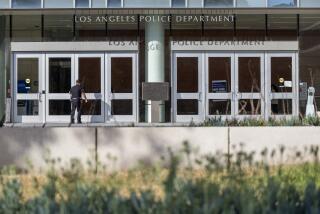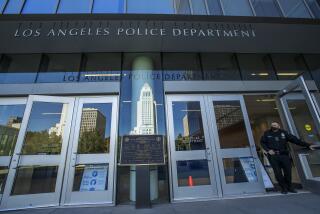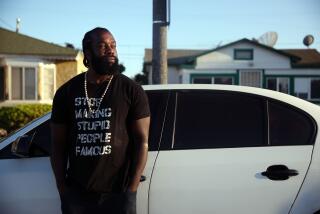Police Commission to judge two questions in Ezell Ford shooting

An activist with Black Lives Matter lights candles at an altar for Ezell Ford in front of L.A. Mayor
- Share via
As members of the Los Angeles Police Commission step behind closed doors Tuesday to judge the officers who killed Ezell Ford, the panel will consider two distinct events.
One is the decision to open fire on Ford, which both Police Chief Charlie Beck and the department’s independent inspector general have found to be justified after investigators turned up evidence indicating that Ford grabbed for an officer’s holstered gun during a struggle, according to sources familiar with the LAPD’s investigation of the shooting.
The other is the officers’ actions in the moments immediately before the shooting, in which they approached the 25-year-old mentally ill black man and tried to detain him.
The inspector general, Alex Bustamante, has raised concerns about whether the officers had a legal justification to make the stop and concluded that their tactics were inappropriate, the sources said. Beck, meanwhile, has urged the commission to find that the tactics were acceptable, according to the sources.
Even if the commission finds Ford posed a deadly threat, it will have to grapple with whether the officers’ decisions and actions beforehand were so flawed that they led to a fatal confrontation that didn’t need to occur.
To answer this, the commission, which oversees the city’s Police Department, will need to make sense of apparent discrepancies between Beck’s and Bustamante’s accounts of what occurred before the killing, said the sources, who spoke on the condition they not be named because the commission had not yet ruled on the case.
In his report on the shooting to the commission, Beck indicated the two officers thought Ford might have purchased drugs shortly before they saw him on a South Los Angeles street near his home, according to the sources. Beck wrote that the officers’ suspicions were based on having seen Ford walking away from a group of people and toward an alley known for drug use, the sources said.
Bustamante, however, offered the commission a significantly different version of events, the sources said. In his own report, he emphasized that the officers acknowledged to investigators they never witnessed Ford interact with the group and that he was 20 or 30 feet away from them when the officers first saw him, according to the sources. No drugs were found on or near Ford, the sources said.
Bustamante’s and Beck’s reports on the shooting have not been made public.
The details of what the officers saw are central to deciding whether the officers had a legitimate reason to stop Ford. If commissioners conclude that the officers had no right to detain Ford, they could hold them responsible for needlessly setting in motion the confrontation that ended with the killing.
Similarly, commissioners will also take into account the way the officers, Sharlton Wampler and Antonio Villegas, chose to apprehend Ford. The LAPD has never publicly explained why the officers stopped Ford as he was walking down the street near his home in South Los Angeles.
Upon catching up to him on the sidewalk, Wampler grabbed Ford, the sources said. LAPD officials have publicly said Ford forced the officer to the ground and grabbed his gun, prompting both officers to open fire. LAPD investigators found evidence supporting the account, including Ford’s DNA on the weapon and scratches on the hands of the officer and Ford as well as the gun’s holster, two sources said.
Bustamante found Wampler’s decision to accost Ford fell far outside the scope of how LAPD officers are trained to handle such situations, according to the sources. Because a person could be armed, officers are taught instead to call out commands to a person from a place of safety, such as behind their open car door.
A decision by the five-member commission to find that the shooting violated the department’s policy on deadly force would be a rare example of the panel going against the recommendation of both Beck and Bustamante.
Beck would then decide what discipline, if any, to impose on the officers. In a handful of previous cases in which the chief was at odds with the commission and felt his officers had acted appropriately, he refused to punish the officers or gave them only a written reprimand, a 2012 Times review found.
Ford’s death sparked local anger amid a national debate over killings by police, particularly those of black men. Ford, who had been diagnosed with bipolar disorder and schizophrenia, died two days after the fatal police shooting of Michael Brown in Ferguson, Mo., which prompted nationwide demonstrations and a intense debate about race and policing.
A report Friday in The Times that Beck and Bustamante would recommend to the commission that the shooting was justified, reignited protests. About a dozen people gathered outside Mayor Eric Garcetti’s Hancock Park residence early Sunday. The demonstrators called on Garcetti to fire Beck and for the Police Commission to conduct its review of Ford’s shooting in public.
Then, on Monday morning, Garcetti had an awkward encounter with activists as he tried to depart to catch a plane for Washington, D.C.
In a video shot by a demonstrator and posted to YouTube, the mayor can be seen walking away from about a dozen protesters and entering a black SUV parked on a side street behind his house. Off-camera, someone shouts, “Why are you sneaking out the back door?”
A second video posted online shows the mayor, seated inside the vehicle, conversing with demonstrators for several minutes through a rolled-down passenger window. In the video, protesters are blocking the SUV’s path and Garcetti is seen pleading with them to move so he can make his plane, saying that he is traveling to the capital to try to secure federal funding to combat homelessness.
“I have to go to Washington right now. This is pre-scheduled,” Garcetti says through the window.
“You always run,” a demonstrator retorts.
Only after police officers intervened did demonstrators let the vehicle proceed. An LAPD spokesman said the department is investigating whether an officer used appropriate force on a protester as the mayor was leaving.
The Ford case is expected to be the first significant test for the Police Commission since it revised its rules last year for how it judges shootings.
For decades, the commission has followed a multi-step process in officer shootings and other deadly force cases. Instead of making a single decision on whether the officer was right to fire, it divides incidents into separate parts.
It first decides if the officer’s actions leading up to the shooting were acceptable. Then it judges the officer’s decision to draw his weapon, and finally the shooting itself.
When judging the decision to use deadly force, the commission previously took a narrow approach, asking only whether the officer faced a deadly threat at the moment he opened fire. Under the new rules, the commission still votes on the three separate categories, but now looks at an officer’s actions in the lead up to the shooting when deciding on the shooting itself.
The change was prompted by a 2013 California Supreme Court decision in a case involving a fatal police shooting in San Diego. In the case, Hayes vs. San Diego, the court made clear that under the state’s laws on police shootings the “totality of the circumstances” should be taken into consideration when judging if an officer’s use of force was unreasonable.
Steve Soboroff, president of the Police Commission, said Monday that he had asked Bustamante and others to advise the commission before it votes Tuesday on whether the Hayes decision and the changes made to the LAPD’s policy as a result were applicable to the Ford case. Soboroff said he also asked that copies of the decision be made available to the commissioners to prepare for their deliberation.
Robert Saltzman, another commissioner, declined to discuss the Ford case specifically, but said, “In my view, Hayes always applies when there is a question about the tactics and whether the pre-shooting decision-making contributed to the eventual use of force.”
Times staff writer Peter Jamison contributed to this report.
More to Read
Sign up for Essential California
The most important California stories and recommendations in your inbox every morning.
You may occasionally receive promotional content from the Los Angeles Times.












